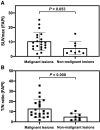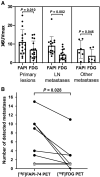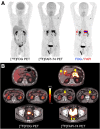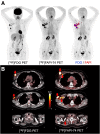Initial Evaluation of [18F]FAPI-74 PET for Various Histopathologically Confirmed Cancers and Benign Lesions
- PMID: 37268427
- PMCID: PMC10394310
- DOI: 10.2967/jnumed.123.265486
Initial Evaluation of [18F]FAPI-74 PET for Various Histopathologically Confirmed Cancers and Benign Lesions
Abstract
The 18F-labeled fibroblast activation protein inhibitor (FAPI) [18F]FAPI-74 has the benefit of a higher synthetic yield and better image resolution than 68Ga-labeled FAPI. We preliminarily evaluated the diagnostic performance of [18F]FAPI-74 PET in patients with various histopathologically confirmed cancers or suspected malignancies. Methods: We enrolled 31 patients (17 men and 14 women) with lung cancer (n = 7), breast cancer (n = 5), gastric cancer (n = 5), pancreatic cancer (n = 3), other cancers (n = 5), and benign tumors (n = 6). Twenty-seven of the 31 patients were treatment-naïve or preoperative, whereas recurrence was suspected in the remaining 4 patients. Histopathologic confirmation was obtained for the primary lesions of 29 of the 31 patients. In the remaining 2 patients, the final diagnosis was based on the clinical course. [18F]FAPI-74 PET scanning was performed 60 min after the intravenous injection of [18F]FAPI-74 (240 ± 31 MBq). The [18F]FAPI-74 PET images were compared between the primary or local recurrent lesions of malignant tumors (n = 21) and nonmalignant lesions (n = 8: type-B1 thymomas, granuloma, solitary fibrous tumor, and postoperative or posttherapeutic changes). The uptake and number of detected lesions on [18F]FAPI-74 PET were also compared with those on [18F]FDG PET for available patients (n = 19). Results: [18F]FAPI-74 PET showed higher uptake in primary lesions of various cancers than in nonmalignant lesions (median SUVmax, 9.39 [range, 1.83-25.28] vs. 3.49 [range, 2.21-15.58]; P = 0.053), but some of the nonmalignant lesions showed high uptake. [18F]FAPI-74 PET also showed significantly higher uptake than [18F]FDG PET (median SUVmax, 9.44 [range, 2.50-25.28] vs. 5.45 [range, 1.22-15.06] in primary lesions [P = 0.010], 8.86 [range, 3.51-23.33] vs. 3.84 [range, 1.01-9.75] in lymph node metastases [P = 0.002], and 6.39 [range, 0.55-12.78] vs. 1.88 [range, 0.73-8.35] in other metastases [P = 0.046], respectively). In 6 patients, [18F]FAPI-74 PET detected more metastatic lesions than [18F]FDG PET. Conclusion: [18F]FAPI-74 PET showed higher uptake and detection rates in primary and metastatic lesions than did [18F]FDG PET. [18F]FAPI-74 PET is a promising novel diagnostic modality for various tumors, especially for precise staging before treatment, including characterization of tumor lesions before surgery. Moreover, 18F-labeled FAPI ligand might serve a higher demand in clinical care in the future.
Keywords: PET; [18F]FAPI-74; cancer-associated fibroblast; fibroblast activation protein; oncology.
© 2023 by the Society of Nuclear Medicine and Molecular Imaging.
Figures






References
-
- Kobayashi H, Enomoto A, Woods SL, Burt AD, Takahashi M, Worthley DL. Cancer-associated fibroblasts in gastrointestinal cancer. Nat Rev Gastroenterol Hepatol. 2019;16:282–295. - PubMed
Publication types
MeSH terms
Substances
LinkOut - more resources
Full Text Sources
Medical
